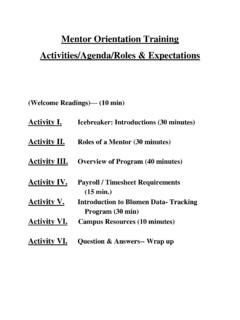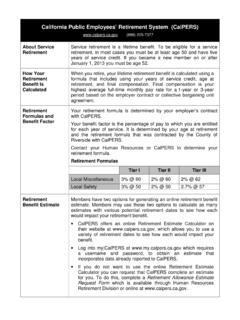Transcription of Partnership Development Training Module
1 Partnership Development Training Module 2 SECTION 1: Partnership Development Module Curriculum Information Sheet for Participants Intended Audience americorps Members ( VISTA americorps Members, SIS americorps Members, Retention Project americorps Members) or Student Leaders Learning Objectives The Training participants will: Understand the continuum from Communication to Collaboration. Understand recognized characteristics of effective campus community partnerships. Reflect on one Partnership in which they are currently engaged to consider whether the Partnership is as effective as they currently view it. Apply their knowledge of effective campus community partnerships by conducting a Partnership strengthening interview.
2 Curriculum Outline Participants are guided to work through the curriculum and materials in this order: 1. Read: What is Partnership and Why is it Important 2. Read Text: Achieving the Promise of Authentic Community Higher Education Partnerships: Community Partners Speak Out!~ Wingspread Conference Report 2006 3. Review the Handout: Continuum from Communication to Collaboration 4. Engage in the Reflection Activity 5. Complete Praxis Activity 6. Review the Reflection Activity: Identify ways to strengthen partnerships 7. Complete the Module assessment/evaluation. Definitions Praxis: Praxis is the process by which a theory, lesson, or skill is enacted or practiced, embodied and/or realized. It is a practical and applied knowledge to one's actions.
3 ~ (process), May 13, 2010. 3 Reflection: Reflection is an active process of discovery, meaning making and connection between what is being learned and how the knowledge or skill is relevant to the learner on any number of levels including professional, personal or societal. Reflection can be done in any number of ways thinking, speaking, writing, visual representation, creative movement or other artistic expressions. Reflection relies on critical thinking to identify, analyze and synthesize the connections made during any reflective activity. SECTION 2: What is Partnership and Why is it Important? What is Partnership ? Partnership is the term used in the field of civic engagement to talk about the existing or intended relationships between individual people and entities pooling or sharing resources, knowledge and other assets to achieve one or more goals that are mutually beneficial.
4 In higher education, the term campus community Partnership is often used to discuss the concept we are exploring in this Training Module . The connotation of these terms is that every person and/entity contributes assets and resources and receives benefit for their participation. The concept of reciprocity is often discussed. Reciprocity being that there is an exchange (goods/labor/services/resources/informat ion) occurring in the relationship. The hope in the civic engagement realm is that this exchange is mutually positive. It is, however, important to note that negative responses and experiences within partnerships occur as well. As individuals working to develop partnerships with community entities, it is the goal to minimize the behaviors and risks that can lead to negative exchange and impact.
5 Furthermore, there exists the underlying intent in the higher education civic engagement field that partnerships expect to produce outcomes that strengthen society. The public purpose of higher education is fulfilled when students learn and apply civic skills that will contribute to the vitality of our democracy for the present and future. The strengthening of society can take many forms. It may be that citizens participating in the Partnership have developed a stronger sense of community with one another. It may be that the effort put forth by the Partnership resulted in addressing a problem or filling a need within a segment of a community. A Partnership can add to a city, state, or nationwide effort to make significant social change. The Retention Project, hosted by Washington Campus Compact, is an example of a statewide effort aiming to increase academic success and college access and to lower the high school drop out rates across the state for low income and at risk populations.
6 Example of a basic Partnership : Great City recently took ownership of a small, unkempt lot in a low to mid income, residential neighborhood. The once private lot was owned by a resident whose home burned down. For 10 years the lot has sat vacant with property taxes unpaid. Recently, the lot was turned over to the city through legal and financial proceedings. Many people in the neighborhood feel the lot is an eye sore and has become a loitering spot for teens and others who are conducting less than positive activities in the area. 4 The city government of Great City and the people of the neighborhood, through the neighborhood association and the Chamber of Commerce have formed a Partnership to revitalize the lot as a neighborhood park that would include a building where students will come to spend time after school working on homework and receiving tutoring and mentoring.
7 Examples Campus Community Partnerships (using the same scenario above): As the partners (city officials, neighborhood association members and local businesses) have started planning the new park and how the work will get done on the lot, they ve decided it would be important to document the process from start to finish perhaps even creating a public display that would stay at the park about how it came into being. Great City s city manager contacts the Center for Civic Engagement and Service Learning at Great City Community College to ask if there is a way for college faculty and students to take an on going part in the existing Partnership . After communication and networking, it is decided that the Community Colleges journalism teacher will take this on as a service learning project.
8 Students will research the history of the property (the previous owners, the fire that left the property vacant, the family who was unable to care for the property) in order to learn investigative journalism. Other students, to learn basic reporting, will follow the Development of the current action by attending and reporting on neighborhood association meetings, city council meetings, and Chamber of Commerce activities that include actions relevant to the park s Development . Other students studying visual journalism will document the demolition and construction project using digital media (cameras, videotape, and on line communication strategies). Together the students will produce a written and visual account and timeline for the new park project. Additionally, after hearing about the project, sociology, English, and math faculty have contacted the Center for Civic Engagement and Service Learning about how they might form partnerships in the future about having their students participate in tutoring and mentoring at the new afterschool drop in facility.
9 Why Partnership is Important Perspective and Ownership: Partnership allows for many people to have a voice in addressing issues and creating positive change. As multiple perspectives are shared, a fuller understanding of the needs, assets, strategies, and abilities needed or available to address an issue are understood. No person or entity appreciates having a solution forced on them by others outside their experience and perspective especially without the ability to suggest the best or most culturally appropriate way to approach the situation. Partnership shows respect and requires open dialog that can allow for authentic understanding and meaningful solutions to arise. At the least, involvement in a Partnership usually leads to increased awareness of issues, needs, strategies, and solutions.
10 At best, life long civic conscientiousness and citizen responsibility to engage in identifying and solving community issues is developed. Access and Resources: Partnership is critical to leveraging and mobilizing necessary resources to achieve any complex goal. It is a rare instance when any one person or entity has access to all the needed information, knowledge, organizational systems, space, social and cultural competency, skill, 5 experience, financial or other physical supports. Convening people or entities that bring to the Partnership the identified and needed resources allows for Partnership to prosper and succeed. Shared Liability: In today s society of rules, regulations, laws, risk management, insurance and litigation it is important for entities to create systems, programs and activities that consider how to protect the people and physical assets of those involved in any endeavor.







